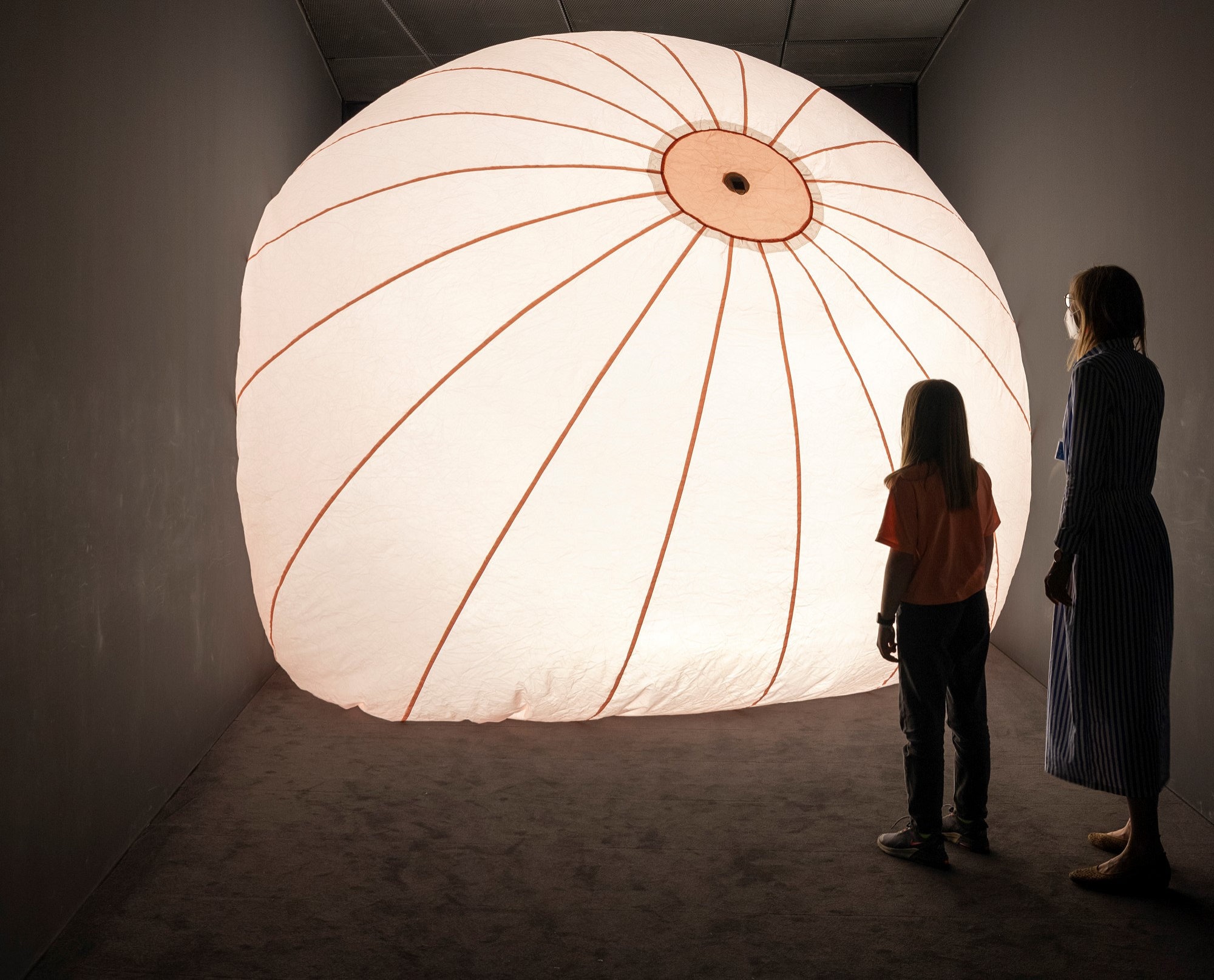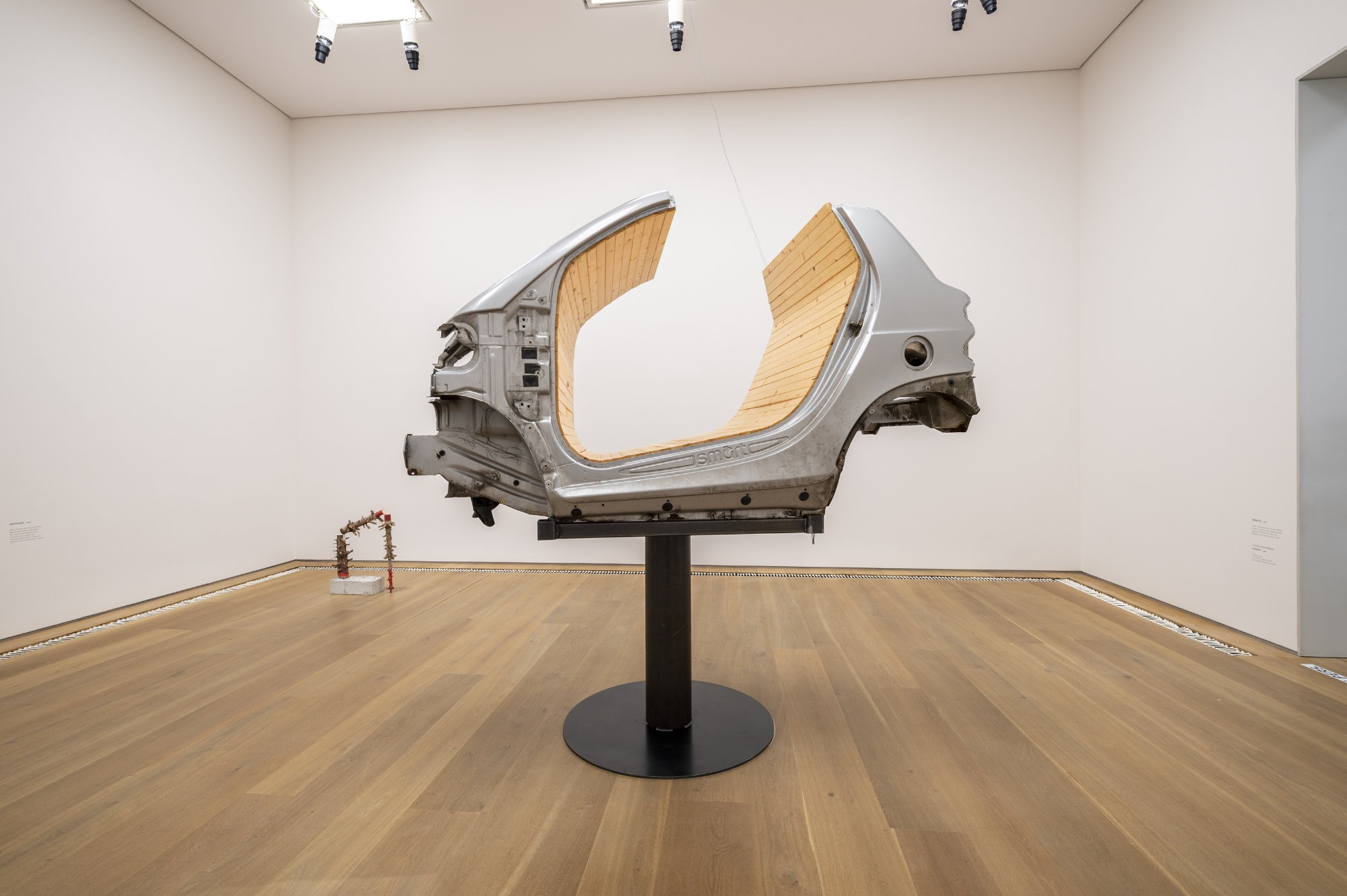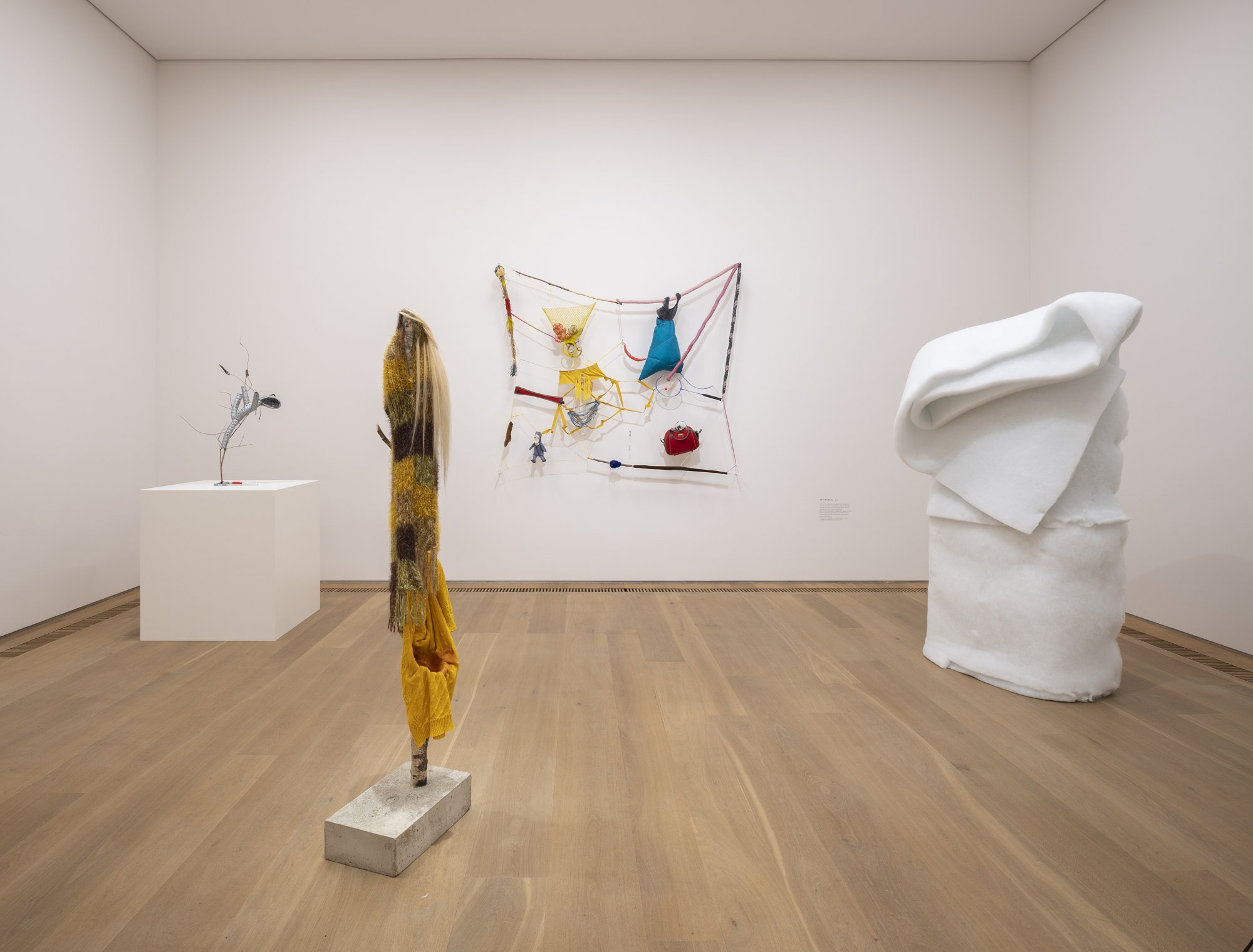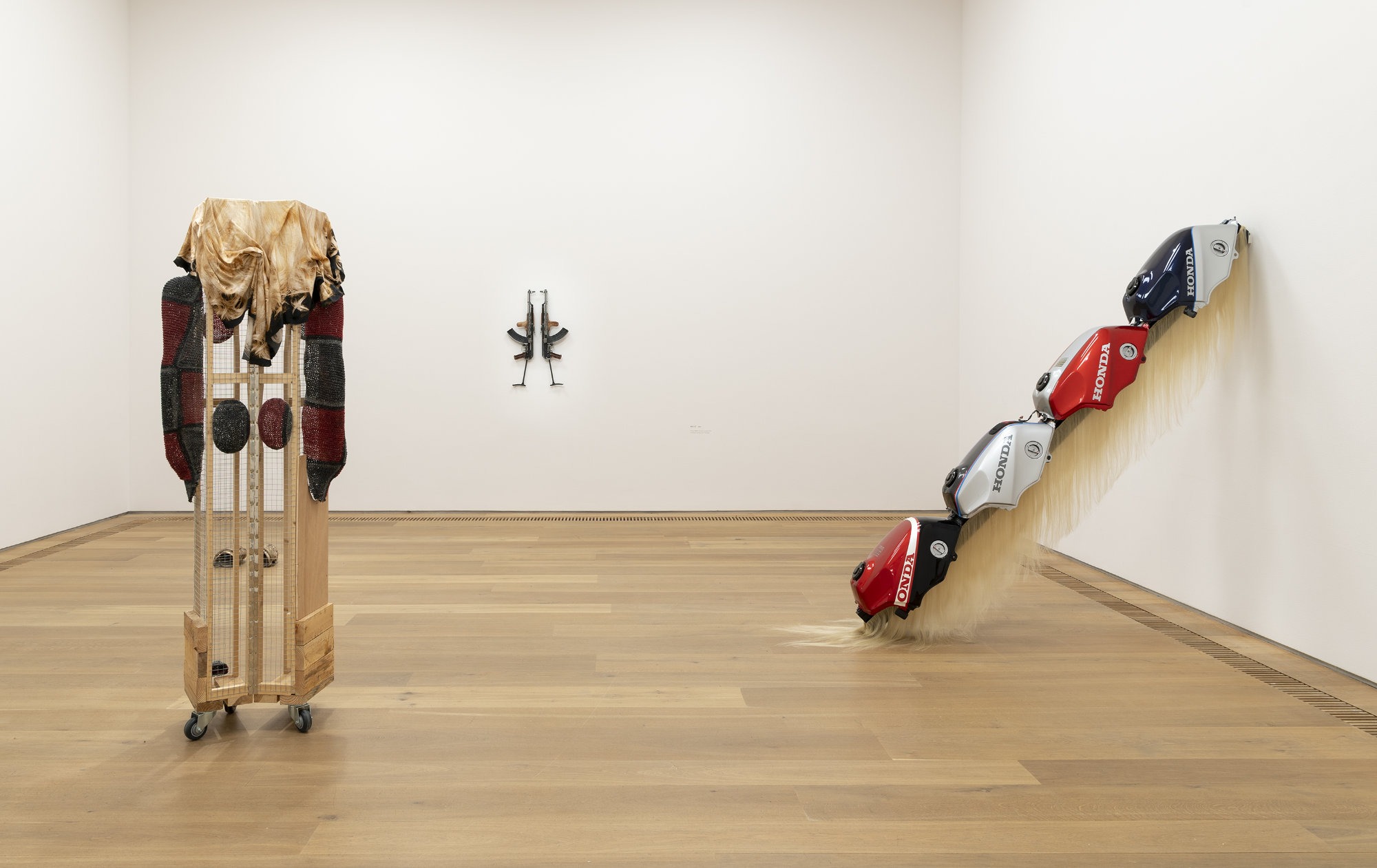Alexandra Bircken
A–Z
28 Jul 2021 - 16 Jan 2022

Exhibition “Alexandra Bircken: A–Z“ at Museum Brandhorst
Shown works: “T(raum) 1“ (2019), “B.U.F.F. (Big, Fat, Ugly, Yellow)“(2014), “RSV 4” (2020), “Skiliesl“ (2010) und “Ohne Titel“ (2011), “Demolition Ball /Cassius” (2011), “Eva (2013)”, “Trolley” II (2016)”
© Alexandra Bircken. Photo: Haydar Koyupinar, Bayerische Staatsgemäldesammlungen, Museum Brandhorst, Munich
Shown works: “T(raum) 1“ (2019), “B.U.F.F. (Big, Fat, Ugly, Yellow)“(2014), “RSV 4” (2020), “Skiliesl“ (2010) und “Ohne Titel“ (2011), “Demolition Ball /Cassius” (2011), “Eva (2013)”, “Trolley” II (2016)”
© Alexandra Bircken. Photo: Haydar Koyupinar, Bayerische Staatsgemäldesammlungen, Museum Brandhorst, Munich

Alexandra Bircken, New Model Army, 2016
Mannequin in metal stand, nlyon, leather, padding. Dimensions each 164 x 26 x 49 cm
Udo und Anette Brandhorst Collection
© Alexandra Bircken. Photo: Haydar Koyupinar, Bayerische Staatsgemäldesammlungen, Museum Brandhorst, Munich
Mannequin in metal stand, nlyon, leather, padding. Dimensions each 164 x 26 x 49 cm
Udo und Anette Brandhorst Collection
© Alexandra Bircken. Photo: Haydar Koyupinar, Bayerische Staatsgemäldesammlungen, Museum Brandhorst, Munich

Alexandra Bircken next to „New Model Army“ (2016) at Museum Brandhorst
Udo und Anette Brandhorst Collection
© Alexandra Bircken. Photo: Haydar Koyupinar, Bayerische Staatsgemäldesammlungen, Museum Brandhorst, Munich
Udo und Anette Brandhorst Collection
© Alexandra Bircken. Photo: Haydar Koyupinar, Bayerische Staatsgemäldesammlungen, Museum Brandhorst, Munich

Exhibition “Alexandra Bircken: A–Z“ at Museum Brandhorst
Visitors in front of “Lunge“ (2013)
© Alexandra Bircken. Photo: Haydar Koyupinar, Bayerische Staatsgemäldesammlungen, Museum Brandhorst, Munich
Visitors in front of “Lunge“ (2013)
© Alexandra Bircken. Photo: Haydar Koyupinar, Bayerische Staatsgemäldesammlungen, Museum Brandhorst, Munich

Alexandra Bircken, Fruit Sticker I, 2021
Digital print on silk, 115 × 115 cm
© Alexandra Bircken. Photo: Haydar Koyupinar, Bayerische Staatsgemäldesammlungen, Museum Brandhorst, Munich
Digital print on silk, 115 × 115 cm
© Alexandra Bircken. Photo: Haydar Koyupinar, Bayerische Staatsgemäldesammlungen, Museum Brandhorst, Munich

Alexandra Bircken, Deine Beine, 2019
Wood, metal joint, leather, nails, leg of a mannequin, acrystal acryic resin, tea towel, epoxy, acorn
© Alexandra Bircken. Photo: Haydar Koyupinar, Bayerische Staatsgemäldesammlungen, Museum Brandhorst, Munich
Wood, metal joint, leather, nails, leg of a mannequin, acrystal acryic resin, tea towel, epoxy, acorn
© Alexandra Bircken. Photo: Haydar Koyupinar, Bayerische Staatsgemäldesammlungen, Museum Brandhorst, Munich

Exhibition “Alexandra Bircken: A–Z“ at Museum Brandhorst
Shown works: “Fruit Sticker I” (2021), “Ursula“ (2020), “Stummer Diener“ (2017), “UZI“ (2015)
© Alexandra Bircken. Photo: Haydar Koyupinar, Bayerische Staatsgemäldesammlungen, Museum Brandhorst, Munich
Shown works: “Fruit Sticker I” (2021), “Ursula“ (2020), “Stummer Diener“ (2017), “UZI“ (2015)
© Alexandra Bircken. Photo: Haydar Koyupinar, Bayerische Staatsgemäldesammlungen, Museum Brandhorst, Munich

Exhibition “Alexandra Bircken: A–Z“ at Museum Brandhorst
Shown works: “Ohne Titel“ (2020) (Installation on the ground), “Rückgrat“ (2019), “Smartie“(2017)
© Alexandra Bircken. Photo: Haydar Koyupinar, Bayerische Staatsgemäldesammlungen, Museum Brandhorst, Munich
Shown works: “Ohne Titel“ (2020) (Installation on the ground), “Rückgrat“ (2019), “Smartie“(2017)
© Alexandra Bircken. Photo: Haydar Koyupinar, Bayerische Staatsgemäldesammlungen, Museum Brandhorst, Munich

Exhibition “Alexandra Bircken: A–Z“ at Museum Brandhorst
Shown works:”Spaceman“ (2005), ”Blondie, begging“ (2010),”Netz mit Maria“ (2008),”Knut“ (2010)
© Alexandra Bircken. Photo: Haydar Koyupinar, Bayerische Staatsgemäldesammlungen, Museum Brandhorst, Munich
Shown works:”Spaceman“ (2005), ”Blondie, begging“ (2010),”Netz mit Maria“ (2008),”Knut“ (2010)
© Alexandra Bircken. Photo: Haydar Koyupinar, Bayerische Staatsgemäldesammlungen, Museum Brandhorst, Munich

Exhibition “Alexandra Bircken: A–Z“ at Museum Brandhorst
Shown works: “Ex“ (2017), “AK 47“ (2016), “Honda Honda Bionda Onda” (2017)
© Alexandra Bircken. Photo: Haydar Koyupinar, Bayerische Staatsgemäldesammlungen, Museum Brandhorst, Munich
Shown works: “Ex“ (2017), “AK 47“ (2016), “Honda Honda Bionda Onda” (2017)
© Alexandra Bircken. Photo: Haydar Koyupinar, Bayerische Staatsgemäldesammlungen, Museum Brandhorst, Munich
How do we approach our immediate environment? Do we seek to shelter from it, or expose ourselves to it without resistance? Are we vulnerable, or armed and unassailable? How does our body compose itself in a technology-focused age where it seems to be no more than an archaic relic? These increasingly relevant questions play a key role in the work of German sculptor Alexandra Bircken.
Born in Cologne in 1967 and now living in Berlin, the artist has been Professor of Sculpture at the Academy of Fine Arts Munich since 2018. She is most renowned for her sculptures and installations, for which she draws on an unusually wide range of materials: everyday objects like hair dye packaging, rocking-horses, and sawn-up motorcycles, but also hand-woven and machine-made textiles, and extending to organic materials including wood, leather, bone, and even a placenta. In Bircken’s hands everything around us can become a sculptural medium.
“My work draws on observations of human life and our environment. It’s about our vulnerabilities and the ways we have of protecting ourselves. And about the expectations and demands that modern society places upon us, and we place upon ourselves. The way we function is often similar to that of machines,” says Bircken. Given this theme, the human body is thus almost always the focus of her works. With its complex states and conditions, its shells and coverings, and its variety of desires, it is the central point of reference in Bircken’s work, which can also be understood as a contribution to a media theory of the body. In thematically structured rooms, the exhibition will for the first time fully examine Bircken’s sculptural vocabulary and bring works from the last two decades into a dialogue that explores the artist’s multilayered statements about surface, body, movement, shell, and skin.
The artist will also create new works for Museum Brandhorst, including an installation that specifically references the architecture of the exhibition space. For this work, Bircken is employing a complex process to replace the ventilation grilles in the floor with large numbers of treated animal bones, collaborating with members of the Faculty of Veterinary Medicine at Ludwig-Maximilians-Universität Munich. The work examines the concept of architecture as a body, stabilized, like a building, by a frame or scaffold while in turn enclosing the skeleton in a protective and defining sheath. By contrast, bones are entities within themselves, representing carriers of complex information and transporting far more knowledge than their smooth surfaces reveal. They likewise draw our attention to something physical, natural, hermetic: the interior of the body, but also our own mortality.
Other pieces in the exhibition are on public display for the first time in a long while. One such highlight is “Lunge” [Lung], an installation first exhibited in 2013 in the Pavilion of the Volksbühne at Rosa-Luxemburg-Platz, Berlin. The huge, luminous pink form, five meters in diameter, continuously inflates until it reaches the physical constraints of the walls before slowly collapsing again. The sculptural object becomes the breathing organ of the museum.
The exhibition was conceived in close collaboration with the artist and is accompanied by an extensive catalog offering the first comprehensive academic overview of her work. After Munich the show will travel to Centre Régional d’Art Contemporain in Sète, France.
Born in Cologne in 1967 and now living in Berlin, the artist has been Professor of Sculpture at the Academy of Fine Arts Munich since 2018. She is most renowned for her sculptures and installations, for which she draws on an unusually wide range of materials: everyday objects like hair dye packaging, rocking-horses, and sawn-up motorcycles, but also hand-woven and machine-made textiles, and extending to organic materials including wood, leather, bone, and even a placenta. In Bircken’s hands everything around us can become a sculptural medium.
“My work draws on observations of human life and our environment. It’s about our vulnerabilities and the ways we have of protecting ourselves. And about the expectations and demands that modern society places upon us, and we place upon ourselves. The way we function is often similar to that of machines,” says Bircken. Given this theme, the human body is thus almost always the focus of her works. With its complex states and conditions, its shells and coverings, and its variety of desires, it is the central point of reference in Bircken’s work, which can also be understood as a contribution to a media theory of the body. In thematically structured rooms, the exhibition will for the first time fully examine Bircken’s sculptural vocabulary and bring works from the last two decades into a dialogue that explores the artist’s multilayered statements about surface, body, movement, shell, and skin.
The artist will also create new works for Museum Brandhorst, including an installation that specifically references the architecture of the exhibition space. For this work, Bircken is employing a complex process to replace the ventilation grilles in the floor with large numbers of treated animal bones, collaborating with members of the Faculty of Veterinary Medicine at Ludwig-Maximilians-Universität Munich. The work examines the concept of architecture as a body, stabilized, like a building, by a frame or scaffold while in turn enclosing the skeleton in a protective and defining sheath. By contrast, bones are entities within themselves, representing carriers of complex information and transporting far more knowledge than their smooth surfaces reveal. They likewise draw our attention to something physical, natural, hermetic: the interior of the body, but also our own mortality.
Other pieces in the exhibition are on public display for the first time in a long while. One such highlight is “Lunge” [Lung], an installation first exhibited in 2013 in the Pavilion of the Volksbühne at Rosa-Luxemburg-Platz, Berlin. The huge, luminous pink form, five meters in diameter, continuously inflates until it reaches the physical constraints of the walls before slowly collapsing again. The sculptural object becomes the breathing organ of the museum.
The exhibition was conceived in close collaboration with the artist and is accompanied by an extensive catalog offering the first comprehensive academic overview of her work. After Munich the show will travel to Centre Régional d’Art Contemporain in Sète, France.
